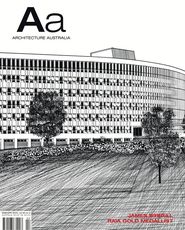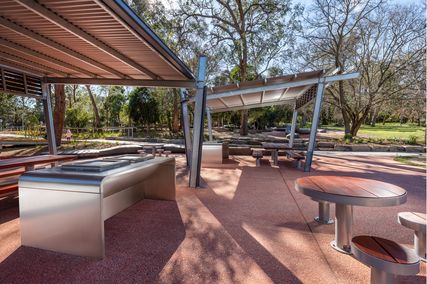SANDRA KAJI-O’GRADY REVIEWS MELBOURNE MASTERS ARCHITECTURE, AN EXHIBITION CURATED BY LEON VAN SCHAIK AT THE TARRAWARRA MUSEUM OF ART THAT COLLECTS THE RECENT WORK OF FIFTEEN MELBOURNE PRACTICES.
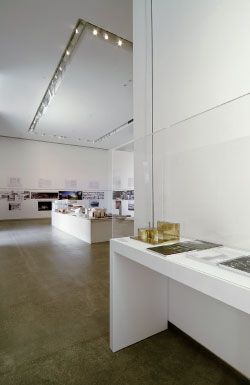
Curated by Leon van Schaik, Melbourne Masters Architecture exhibits work from Melbourne practices involved in RMIT’s Masters by invitation programme.
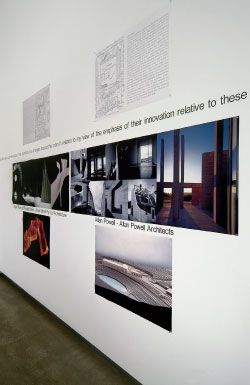
Diagrammatic sketches and captions by van Schaik frame the work of the selected practices.
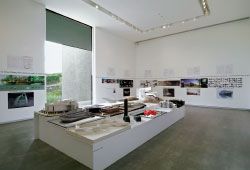
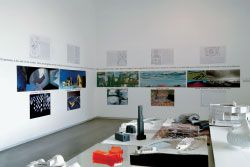
Overviews of the exhibition.Photography: Dianna Snape
CURATED EXHIBITIONS OF contemporary architecture typically construct an argument about what is new and deserving of attention and why this is so; selecting a number of projects with perceived commonalities from the totality of architectural production. They can have far greater historical impact than individual projects – just think of Hitchcock and Johnson’s International Style (1932), Portoghesi’s Presence of the Past (1980) or Wigley and Johnson’s Deconstructivist Architecture (1988).
Melbourne Masters Architecture at the TarraWarra Museum of Art presents the work of fifteen firms from the past decade. While reflecting the pluralist state of contemporary practice, the work on display is too diverse to cohere as an argument in favour of any particular aesthetic or theoretical position. Installation designer Niki Kalms works hard to bring visual unity to the show, but it is not possible to intellectually reconcile the baroque spatial explorations of Ivan Rijavec with the tectonic parsimony of Sean Godsell, or the decorative refinements of John Wardle with the indecorum of Edmond and Corrigan. The projects threatened to sabotage the curator’s valiant attempts to categorize them into an all-encompassing schema, while the exhibition dispels any notions that Melbourne possesses a local architectural character. Indeed, the only thread linking these practices, as van Schaik explains in the slim catalogue, is that one of their partners “had participated in or mentored the Masters by invitation programme at RMIT”.
This is not, however, a school show. Most of the exhibited work was undertaken in the collaborative context of practice, and not by individuals towards the degree. Rather, the show intends an argument about how the Masters programme has influenced those involved in it (or, at least, a small proportion of those who practise locally). More specifically, given that a further selection criterion is that the architects “have maintained a critical engagement” with the curator, the exhibition is about the relationship between van Schaik and the exhibitors as it has formalized and developed through the Masters by invitation. This conclusion is reinforced by the fact that it is van Schaik who provides the diagrammatic drawings and captions that frame the photographs and models of architectural projects, not the participating architects.
On show are the curator’s reflections upon the various ambitions of the architects and the effects and formal achievements of their numerous projects. This might seem egoistic but in fact it is not a trivial reason for launching an exhibition. Van Schaik has been singularly important in reinforcing the intense and public discourse about architecture and the city that characterizes the Melbourne scene. Moreover, he has established a model for a Masters degree by project that many Australian universities are now trying to emulate and defend in the context of funding conditions that do not easily support research by design. Evidence that a Masters degree by project leads to mastery in practice, and subsequently to the improvement of the built environment, is sorely needed.
Although the RMIT Masters by invitation is ostensibly for architects who already demonstrate “mastery”, the exhibition could have demonstrated the significance of the degree on individual career trajectories if it had been more rigorously conceived. There are too many alternative influences and commonalities to expect the argument to be won by implication alone. For example, in 1986, the year before van Schaik took up the position as Head of the Architecture programme at RMIT, Ivan Rijavec, Ian McDougall, Howard Raggatt, Peter Corrigan and Norman Day exhibited at the George Paton Gallery in a show called Artists and Architects. Each architect was paired with an artist and all but Day are in the current exhibition at TarraWarra. Given the many other instances of collaboration between the exhibiting architects and artists, it is an equally plausible contention that the strength of these architects, including those of the younger generation, lies in their openness to the art world and the experimental strategies that can be gleaned from it.
This is not to discount the significance of the RMIT Masters, simply to say that evidence, rather than inference, is required. I would have liked those projects undertaken for the degree and those in practice lain out alongside, and distinguished from, each other. Knowing where involvement in the Masters sat chronologically in each architect’s oeuvre would have been helpful. Changes in direction, refinements, increased focus or greater experimentation might have been made tangible. Comments from the architects about the importance of formally undertaking design research for the degree would have supported the case and deepened viewers’ insights into the profession. Some description of the aims of the Masters degree, its structure and submission requirements would also have assisted the viewer. The short excerpts from published essays by the curator on each of the practices or individual projects were not always that helpful, even for the architecturally informed.
Despite these reservations, what clearly comes across is van Schaik’s appreciation for, and support of, disparate, even contradictory, architectural positions. He has been an unwavering champion for the profession and architectural education. The establishment of a context in which architects can pursue individual concerns, yet are forced to articulate them amongst equally passionate peers, has contributed to the mastery of architecture these practices have achieved.
DR SANDRA KAJI-O’GRADY IS A SENIOR LECTURER IN ARCHITECTURE AT THE UNIVERSITY OF MELBOURNE.

